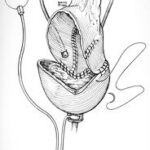 A diseased urinary bladder with low capacity and low compliance (ability to urinate) may require ileal enterocystoplasty (remove a part of the small intestine and attach it to the bladder to enlarge it and improve function [photo]).
A diseased urinary bladder with low capacity and low compliance (ability to urinate) may require ileal enterocystoplasty (remove a part of the small intestine and attach it to the bladder to enlarge it and improve function [photo]).
Researchers at Hospital Foch, in Suresnes, France, studied a cranberry preparation with high levels of proanthocyanidin A (inhibits bacteria from sticking to tissue) to prevent repeated bacteriuria in people with an ileal enterocystoplasty.
First, the details.
- 15 patients who after enterocystoplasty had repeated urinary infection and/or the presence of bacteria in the urine (bacteriuria) were studied.
- They received a cranberry (Vaccinium macrocarpon) preparation containing high levels of proanthocyanidin A (36 mg) once daily.
- Absence of bacteria in urine culture was the main outcome.
- In addition symptoms (pain, fever), continence, and upper excretory tract enlargement were monitored.
- Each patient was their own historical control.
And, the results.
- Patients were treated with the cranberry compound was about 33 months.
- There was a significant decrease in the number of positive urine cultures during cranberry compound treatment.
The bottom line?
The authors concluded, “Treatment with a cranberry compound seems to be effective in reducing asymptomatic bacteriuria in patients with an ileal enterocystoplasty.”
For this special group of patients the authors have identified a cranberry formulation and treatment regimen that’s effective at lowering the risk of asymptomatic bacteriuria.
It would be interesting to study this cranberry compound in a broad range of people with bacteriuria.
More about asymptomatic bacteriuria can be found here.
7/30/10 20:58 JR